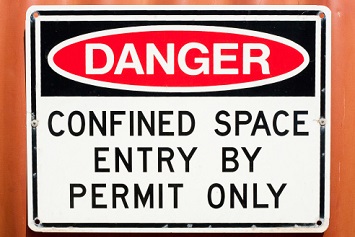Three years ago this month, OSHA issued a new standard for construction work in confined spaces; the standard became effective August 3, 2015. The rule was similar in many respects to the general industry confined spaces standard while also incorporating construction-specific hazards. One issue employers regularly confront under the construction standard is the difference between a confined space and a permit space. Employers must evaluate all confined spaces to determine whether they are permit spaces but must take steps to protect workers only if a space is classified as a permit space.
Here are several aids to understanding the differences between confined spaces and permit spaces, which OSHA provides in Protecting Construction Workers in Confined Spaces: Small Entity Compliance Guide.
Definitions
First, the two definitions:
- A confined space is a space that is large enough and so arranged that an employee can bodily enter it; has limited or restricted means for entry and exit; and is not designed for continuous employee occupancy.
- A permit-required confined space (permit space) is a confined space that contains or has the potential to contain a hazardous atmosphere; contains a material that has the potential for engulfing an entrant; has an internal configuration such that an entrant could be trapped or asphyxiated by inwardly converging walls or by a floor that slopes downward and tapers to a smaller cross section; or contains any other recognized serious safety or health hazard.
Four Questions
Under the construction standard, a competent person (defined by OSHA as a person capable of identifying existing and predictable hazardous conditions and who has the authority to address them promptly) must answer the following four questions to determine whether a confined space is a permit space. If the answer to one or more of the questions is “yes,” the space is a permit space.
- Does the space contain or have the potential to contain a hazardous atmosphere? Most deaths and injuries in confined spaces result from atmospheric hazards. Such hazards include insufficient oxygen and toxic or flammable chemicals.
- Does the space contain a material with the potential to engulf an entrant? Engulfment means the surrounding and effective capture of a person by a liquid or finely divided (flowable) solid substance that can be aspirated to cause death by filling or plugging the respiratory system or that can exert enough force on the body to cause death by strangulation, constriction, or crushing; or the substance suffocates the individual.
- Does the space have an internal configuration such that an entrant could be trapped by inwardly converging walls or by a floor that slopes downward and tapers to a smaller cross section? An area of a confined space with a small cross section can develop a hazardous atmosphere if ventilation is inadequate. In addition, a space of this configuration could prevent an injured worker from escaping the space and add to the difficulty of rescuing the worker.
- Does the space contain any other recognized serious safety or health hazard(s) that pose an immediate danger to a worker’s life or health or would impair the worker’s ability to escape from the space in the event of an injury? Hazards the competent person should consider include fire and explosion hazards; the presence of mechanical, electrical, hydraulic, and pneumatic energy; temperature extremes; radiation; noise; corrosive chemicals; and biological hazards, such as venomous animals or insects.
Required Written Program
If an employer’s workers will enter a permit space, the employer must develop a written permit space program, and entry is only permitted under the terms of the program. Also, the employer must inform employees in the vicinity of the permit space of the dangers it poses. This can be done by posting signs that prohibit entry or by providing effective training on and enforcement of a work rule against entry.

